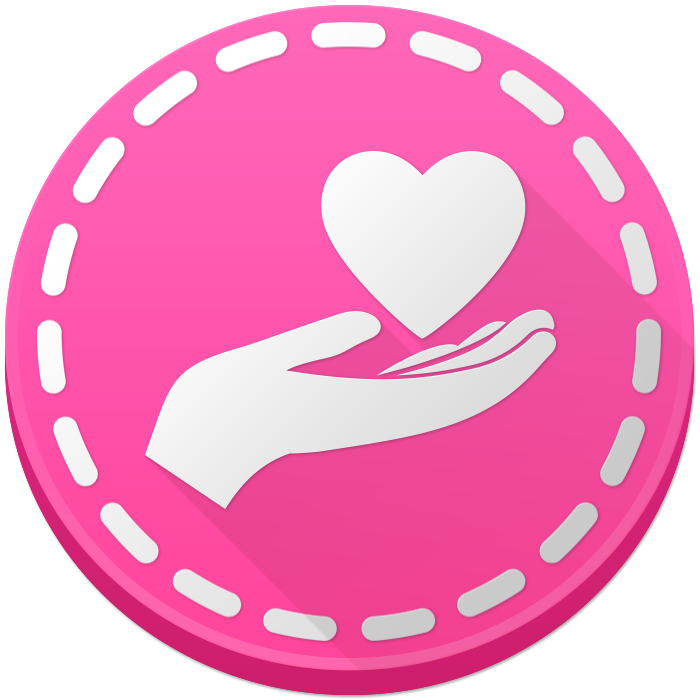HEARTS IN HEALTH
Is Art the Right Prescription?
by Bivi Franco on 08/10/16
Since the beginning of modern medicine, doctors have weighed heavily on the developments and research from pharmaceutical companies to heal their patients. As time has went on, new research has emerged and some doctors are exploring non-traditional healing practices and “writing” new prescriptions to complement their plan of action. These prescriptions are to address the patient’s wellness and quality of life while undergoing treatment. According to the chapter titled, “Arts for health in community settings: promising practices for using the arts to enhance wellness, access to healthcare, and health literacy” in the Oxford Textbook of Creative Arts, Health, and Wellbeing, authors Jill Sonke and Jenny Baxley Lee assert:
Use of the arts as a means to educate the public, foster social
engagement and social change, and influence the behaviours of targeted
populations has a long history. Arts-based health promotion has its
historical roots in traditional cultures where story-telling, drama, and
song are primary means for facilitating healing and enforcing the belief
systems of a given culture. (3)
As the authors state, the use of arts in health has been a long studied tradition that has been shown to influence positive health outcomes. Arts-based programs include painting, pottery and jewelry-making workshops like Workshops with Patients and Through My Window programs. Programs like these provide an outlet for emotional release and exploration as providing an atmosphere where the focus is on their ability to create and beauty instead of their health issues. Our organization was created with the purpose of providing love, hope and encouragement to women and girls affected by cancer through Arts in Health program. In providing love, hope and encouragement, we hope to also focus on their whole wellness and quality of life.
Sonke and Lee stated that “According to the National Wellness Institute in the United States,
wellness is an active process through which people become aware of, and
make choices toward, a more successful existence (Hettler 1976)” (4). Hospitals and cancer centers like our 15 beneficiaries-in-kind are placing importance and making room for much needed health programs like ours. The arts are ideally suited for promoting this integrated approach. Numerous studies demonstrate that arts participation can affect health behaviour and promote wellness in individuals across the life course (Stuckey and Nobel 2010; Hanna et al.
2011; Camic and Chatterjee 2013) (4).
As the concept and field of arts and health grows, partnerships are flourishing and positive outcomes are yielded. Research is trending towards the creative arts influencing more positive outcomes and creating a better quality of life for patients. Only time will tell if it is truly the right prescription. Feel Beautiful Today hopes to continue its work of positively impacting cancer patients’ quality of life.
Reference:
Sonke, J. and Baxley Lee, J. (2015). Arts for health in community settings: promising
practices for using the arts to enhance wellness, access to healthcare, and health literacy In Oxford Textbook of Creative Arts, Health, and Wellbeing: International perspectives on practice, policy and research (pp. 1-22). Oxford University Press.
Connecting Creative Arts and the Patient
by Bivi Franco on 07/06/16
Cancer patients face tough decisions regarding their treatment plans and quality of life. The disease changes the course of their lives and the lives of their families and friends in an instant. Many patients look for a silver lining and for ways to brighten a dim situation and sometimes dark experience. Patients looks for new and creative ways to cope with their illness. Arts in healthcare focuses on the whole picture. It focuses on improving the hospital experience for the individual patient while focusing on expression with their well being as the key component.
In the review, “The Connection Between Art, Healing, and Public Health: A Review of Current Literature” authors Heather L. Stuckey and Jeremy Nobel explore the relationship between creative arts and health outcomes, specifically the extent to which creative arts reduce psychological and physiological outcomes. According to their review of a study conducted, they concluded that women who took part in a qualitative study focusing on cancer described ongoing cancer-related difficulties such as fear for the future, pain, sleeplessness, role loss, activity restriction, reduced self-confidence, and altered social relationships (Stuckey and Nobel, 257). The study reviewed concluded that engaging in different types of visual arts helped the women to “(1) focus on positive life experiences, (2) enhanced their self-worth and identity by providing them with opportunities to demonstrate continuity, challenge and achievement, (3) enabled them to maintain a social identity not defined by cancer, and (4) allowed them to express their feelings in a symbolic manner, especially during chemotherapy” (257).
As the research continues and the field expands, the authors assert that “medical professionals are beginning to recognize the role that creative arts play in the health process; increasingly, arts in medicine programs are emerging throughout the United States and worldwide” (258). Stuckey and Nobel are able to conclusively say that it is clear that artistic engagement has positive effects on health, however they are quick to note that there are limitations within their review because of the limited sample of studies and emergence of new literature (261).
Like the study conducted, women faced with diagnosis of cancer have fears and concerns and creative arts and expression lend them a valuable outlet. Feel Beautiful Today is created with the purpose of providing love, hope and encouragement to women and girls affected by cancer through Arts in Health programs. Through programs like Joined In Hope and Through My Window, FBT hopes to continue to foster environments where patients can release their fears and focus on healing.
Reference:
Stuckey, Heather L., and Jeremy Nobel. “The Connection Between Art, Healing, and Public Health: A Review of Current Literature.” American Journal of Public Health 100.2 (2010): 254–263. PMC.
Art, Positive Thoughts and Adjustment
by Bivi Franco on 05/27/16
One of the scariest feelings we face as humans is the stripping of a sense of control over our lives. Cancer patients confront this feeling the moment they are diagnosed and continue to face an overwhelming sense of helplessness as they fight the disease. Along with this loss of control comes fear, doubt and uncertainty which permeates every part of patients’ lives, ultimately affecting their quality of life. If the thought life of cancer patients is so powerful, would being able to unravel the cause of the cancer provide relief? Is there a way to help patients feel “in control” again, and would that positively affect their adjustment to life with cancer?
In the study “Attributions, Beliefs About Control, and Adjustment to Breast Cancer,” authors Shelley Taylor, Rosemary Lichtman and Joanne Wood ask those exact questions. According to their findings, assigning causality to their cancer did not positively or negatively affect patients’ adjustment to having cancer or recovery. The only negative correlation the researchers found was that assigning blame to another person for their cancer caused emotional distress, which in turn affected their quality of life. Instead, the study finds a strong link between how patients view the amount of control they have and a positive adjustment.
In his writings, S.C. Thompson describes four types of control people exercise when attempting to process or adjust to a new situation: “cognitive control (thinking about the aversive experience differently); information control (learning about the aversive experience); behavioral control (affecting the aversive circumstance through some direct action); and retrospective control (deciding after the fact that one could have controlled the aversive event and that one presumably can do so in the future)” (Taylor 491). Taylor, Lichtman and Wood’s findings show that cognitive control benefits cancer patients the most. Thinking about their situation in a different way improves patients’ quality of life and allows them to adjust to the new reality of their cancer in a positive way. Behavioral control also helps patients adjust, specifically an increase in exercise and “taking increased time for leisure activities” (497).
With such a great need for patients to see life through a positive lens as well as participate in activities that help them regain a sense of control, Feel Beautiful Today is committed to bringing Arts in Health programs like Workshops With Patients, Joined in Hope, Through My Window and LUNA that provide the opportunity and space for patients to experience hope and encouragement. Whether working on creative activities in Art Care Packages or working with one of our workshop facilitators on making a bracelet or necklace, FBT’s programs help patients focus on the beauty in their lives as well as physically and emotionally relax and rest.
Often we cannot control the situations we encounter in life, but we can control how we think about them. It is FBT’s mission to continue to plant seeds of hope where the world feels very much out of control and to equip patients with the tools they need to adjust well.
Reference:
Taylor SE, Lichtman RR, Wood JV. “Attributions, Beliefs About Control, and Adjustment to Breast Cancer.” J Pers Soc Psychol. 1984 Mar; 46(3): 489-502.
The Importance of Patient-Centered Care
by Bivi Franco on 03/24/16
If there’s one thing that every patient wants, it is to know that they are not simply a number or another case to be solved. We as humans have an innate need to be known, and that need bleeds into our health and how we are treated. In a world where phone conversations happen with automated machines, patients need to know that they are being heard and that their road to recovery is neither a dictatorship nor one of neglect but rather a partnership.
So what is patient-centered care? There are many schools of thought concerning the parameters of how involved patients are in the final say of their treatment, but several components are found in every school of thought. The first is that there is “a clear focus on the individual patient” (Miles 210). The second is that “establishing and maintaining healing relationships is central to delivering high quality healthcare” (211). And the third is that “the treatment of disease rests upon an understanding of illness in the context of the individual patient” (215).
Contrary to Evidence-based Medicine, patient-centered care balances the unique needs and history of the individual patient with the scientific advances prevalent in medicine. It is a unique dance between cold, hard research and tender, compassionate care of a person in which there is a balance that allows the humanistic needs to be met while conquering the physiological disease itself. M Gerteis breaks down patient-centered care into eight elements: “(1) respect for patients’ preferences, their values and self-expressed needs; (2) physical comfort; (3) emotional needs; (4) communication, information, education and explanation; (5) access to healthcare services; (6) continuity of care and follow-up; (7) involvement of the patients’ family and friends in the care process and decision-making & (8) co-ordination and integration of healthcare services” (211).
Feel Beautiful Today has the privilege of partnering with hospitals and cancer centers to help provide patient-centered care through Arts in Health programs. The programs we offer provide a space and time for hospital staff to engage their patients in personal, meaningful relationships that strengthen their trust in and respect for one another. Patients also are given the opportunity to explore their mental and emotional health in a safe environment that better allows them to voice their feelings to nurses and doctors, providing more open channels for communication and better care.
Reference:
Miles, Andrew, & Juan Mezzich. "The Care of the Patient and the Soul of the Clinic: Person-Centered Medicine as an Emergent Model of Modern Clinical Practice." International Journal of Person Centered Medicine [Online], 1.2 (2011): 207-222. Web. 24 Mar. 2016.
Art and Symptom Management
by Bivi Franco on 02/10/16
Imagine being told that you are fighting an unknown enemy. Imagine that you have no idea what that enemy will do or if you can even beat it. Imagine that enemy threatening the way you live your life, whether your friends abandon you or not, and the way you see the world. Now imagine that enemy lives inside of you, and the only way to get rid of it is to essentially "kill" parts of your body. This is the reality of a cancer diagnosis, and with that cancer diagnosis is the knowledge you will come face to face with pain.
Next to confronting one's own mortality, "pain is one of the most feared aspects of cancer" and one of the most difficult things to manage (Goodwin 1637). Unlike other forms of chronic pain, most symptoms of pain in cancer patients are directly related to the treatment they are receiving for their cancer. According to research, "It has long been recognized that untreated or undertreated pain is common…with little evidence of recent improvement" (1637). So what are some of the symptoms of these life-saving treatments cancer patients undergo? According to the study "Pain in Cancer Survivors," chronic pain syndromes cancer patients experience include phantom pain, chest pain or tightness, nerve pain, muscle cramps or spasms, carpal tunnel, osteoporosis, dry or burning eyes, ulcers, and a host of other symptoms (Glare 1741). With such a real problem in identifying and managing cancer patients' pain, can art assist in providing some relief?
More and more doctors are beginning to see the benefits of art in their patients' recovery and the ability to provide their patients person-centered pain management. For many cancer patients, the difficulty of trying to express what they feel in their body is just as much of a burden as the pain itself. Art provides patients a vehicle to express their physical pain in ways that words cannot and in ways that doctors can better understand. As Marjana Bras states, "Art can…be one of the best forms of educating medical professionals and others involved in treatment and decision-making on pain" (296). With open channels of communication between doctor and patient, the risk of pain going untreated diminishes, and doctors can make more informed decisions in their patient's pain treatment plans.
Feel Beautiful Today agrees and offers Arts in Health programs in order for cancer patients to live a more full life. With the new year, a brand new program called Through My Window is rolling out to provide patients with the opportunity to both explore and express the pain they are feeling. It is our hope that through this art program, doors will open for better communication between doctors and patients as to what is needed to better manage pain symptoms.
References:
Braš M, Dordevic V, Janjanin M. Person-centered pain management - science and art. Croatian
Medical Journal. 2013; 54(3): 296-300.
Glare PA, Davies PS, Finlay E, et al: Pain in cancer survivors. J Clin Oncol. 2014; 32(16):
1739-1747.
Goodwin PJ, Bruera E, Stockler M: Pain in patients with cancer. J Clin Oncol. 2014 Jun 1; 32(16):
1637-9.




